Input interpretation

silicon tetrachloride
Chemical names and formulas
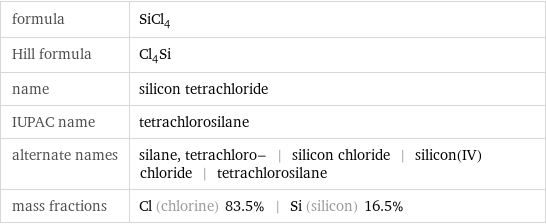
formula | SiCl_4 Hill formula | Cl_4Si name | silicon tetrachloride IUPAC name | tetrachlorosilane alternate names | silane, tetrachloro- | silicon chloride | silicon(IV) chloride | tetrachlorosilane mass fractions | Cl (chlorine) 83.5% | Si (silicon) 16.5%
Lewis structure
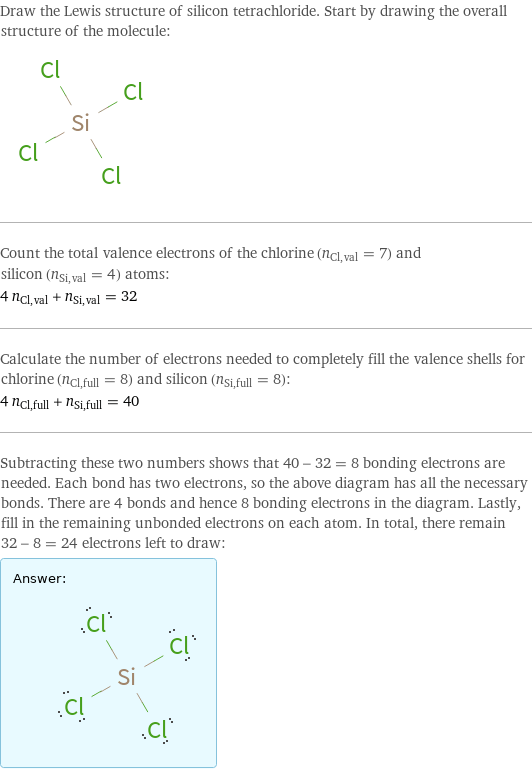
Draw the Lewis structure of silicon tetrachloride. Start by drawing the overall structure of the molecule: Count the total valence electrons of the chlorine (n_Cl, val = 7) and silicon (n_Si, val = 4) atoms: 4 n_Cl, val + n_Si, val = 32 Calculate the number of electrons needed to completely fill the valence shells for chlorine (n_Cl, full = 8) and silicon (n_Si, full = 8): 4 n_Cl, full + n_Si, full = 40 Subtracting these two numbers shows that 40 - 32 = 8 bonding electrons are needed. Each bond has two electrons, so the above diagram has all the necessary bonds. There are 4 bonds and hence 8 bonding electrons in the diagram. Lastly, fill in the remaining unbonded electrons on each atom. In total, there remain 32 - 8 = 24 electrons left to draw: Answer: | |
3D structure
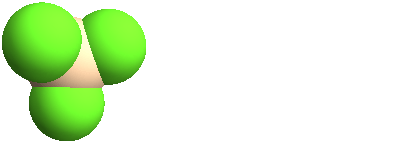
3D structure
Basic properties
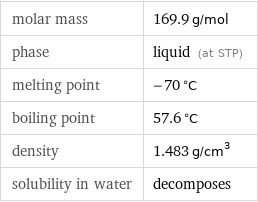
molar mass | 169.9 g/mol phase | liquid (at STP) melting point | -70 °C boiling point | 57.6 °C density | 1.483 g/cm^3 solubility in water | decomposes
Units

Liquid properties (at STP)
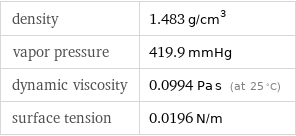
density | 1.483 g/cm^3 vapor pressure | 419.9 mmHg dynamic viscosity | 0.0994 Pa s (at 25 °C) surface tension | 0.0196 N/m
Units

Thermodynamic properties
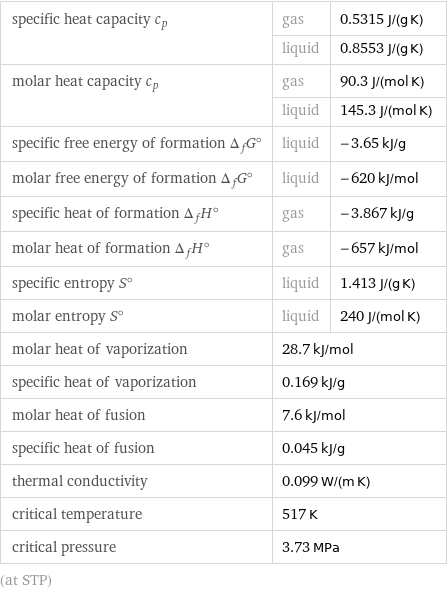
specific heat capacity c_p | gas | 0.5315 J/(g K) | liquid | 0.8553 J/(g K) molar heat capacity c_p | gas | 90.3 J/(mol K) | liquid | 145.3 J/(mol K) specific free energy of formation Δ_fG° | liquid | -3.65 kJ/g molar free energy of formation Δ_fG° | liquid | -620 kJ/mol specific heat of formation Δ_fH° | gas | -3.867 kJ/g molar heat of formation Δ_fH° | gas | -657 kJ/mol specific entropy S° | liquid | 1.413 J/(g K) molar entropy S° | liquid | 240 J/(mol K) molar heat of vaporization | 28.7 kJ/mol | specific heat of vaporization | 0.169 kJ/g | molar heat of fusion | 7.6 kJ/mol | specific heat of fusion | 0.045 kJ/g | thermal conductivity | 0.099 W/(m K) | critical temperature | 517 K | critical pressure | 3.73 MPa | (at STP)
Chemical identifiers
(Cl)(Cl)Cl InChI identifier | InChI=1/Cl4Si/c1-5(2, 3)4 RTECS number | VW0525000 MDL number | MFCD00011229](../image_source/5fab56554e72da69e5d6ffc5a61b9b8e.png)
CAS number | 10026-04-7 PubChem CID number | 24816 PubChem SID number | 24852870 SMILES identifier | [Si](Cl)(Cl)(Cl)Cl InChI identifier | InChI=1/Cl4Si/c1-5(2, 3)4 RTECS number | VW0525000 MDL number | MFCD00011229
NFPA label

NFPA label
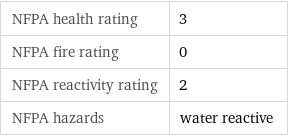
NFPA health rating | 3 NFPA fire rating | 0 NFPA reactivity rating | 2 NFPA hazards | water reactive
Safety properties

flash point | -18 °C

DOT hazard class | 8 DOT numbers | 1818
Toxicity properties

RTECS classes | primary irritant